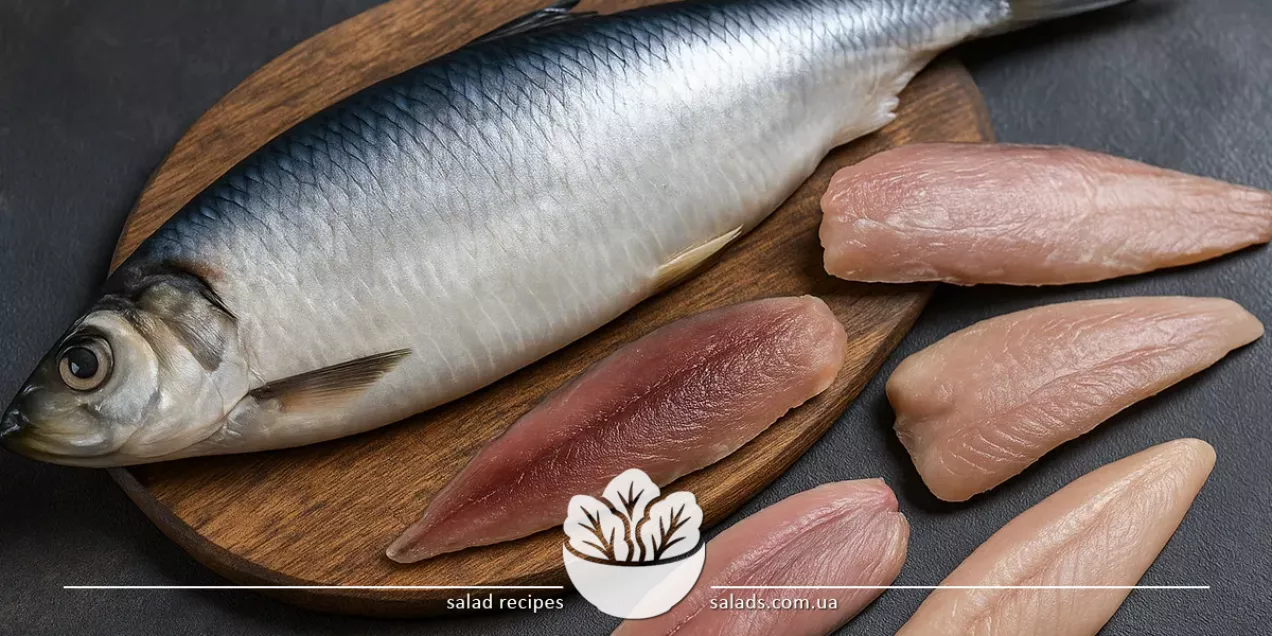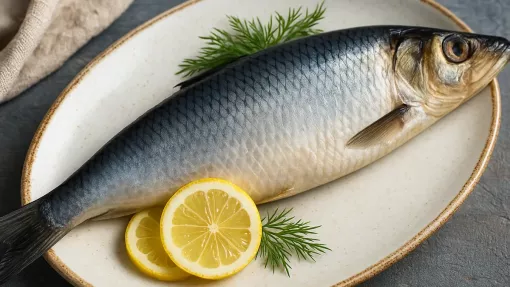Herring

Herring is a fatty sea fish from the cold waters of the Atlantic Ocean that has gained particular popularity in appetizers due to its intense flavor, high content of omega-3 fatty acids, and versatility in culinary use. Depending on the region, herring may be served as a whole fish, in fillets, or as pieces in marinade or spiced brine. It is not boiled or fried – instead, it is prepared by salting or marinating, which preserves its nutritional properties. Within the fish category, herring holds an important place as a traditional ingredient in both everyday and festive meals.
Different Types of Herring
Salted Herring: A Classic for Appetizers and Homemade Dishes
Salted herring is the most common and traditional way to consume this fish. Thanks to natural salting without heat treatment, it retains a tender texture, distinctive taste, and most of its nutrients. In its classic form, herring is simply salted in a solution of water and salt, sometimes with bay leaf and black pepper added. The result is a rich-tasting product with a pronounced sea aroma and a soft, buttery texture. This type of herring is ideal for making sandwiches, salads, and appetizers for both everyday and special occasions. For instance, herring fillets are often served with boiled potatoes, onions, apples, and topped with sour cream or mustard. Due to its richness, it pairs well with vegetables, tangy or spiced additions, and cooked grains. In a simple salad, herring can be combined with boiled eggs to add protein and soften the overall flavor.
Salted herring is often used in dishes such as "herring under a fur coat," vinaigrette, cream cheese rolls, or tartlets. It requires no cooking, which makes it a convenient choice for quick recipes. One consideration is the salt level: sometimes, it is recommended to soak herring in water or milk before use to reduce its saltiness. Despite its simplicity, salted herring comes in many variations: different salt levels, slicing styles, spice proportions – all of which influence the final taste. It is appreciated for both its nutritional value and affordability, making it one of the most accessible fish products suitable for everyday meals and festive tables alike.
Spiced Herring: Depth of Flavor and Culinary Flexibility
Spiced herring is a variation of the salting process that includes vinegar, sugar, allspice, cloves, coriander, bay leaves, and other spices along with salt. This gives the fish a pronounced aroma, more complex flavor, and improved shelf life. The flavorful brine not only enhances the taste but also reduces the saltiness, making it more appealing to a broader audience. This type of herring is particularly popular in appetizers. It can be served on its own with onion slices and herbs or as an ingredient in more elaborate dishes, such as tartlets or canapés with cream cheese and vegetables. It also pairs well with fruits – especially those that are sweet and crisp. A refined appetizer may include herring with grated apple and horseradish, served in small portions.
Spiced herring retains all the benefits of a natural product: it is rich in fatty acids, protein, and vitamins D and B12. It pairs easily with boiled potatoes, beets, carrots, or pickled vegetables. Thanks to its intense flavor, it can serve as the centerpiece of a dish, forming the core of both the taste and presentation. Moreover, it is easy to store: a glass jar in the fridge ensures a ready-to-eat appetizer at any moment. This makes it an excellent option for those who value a balance of rich taste, healthy fats, and convenience. Its culinary flexibility allows it to be used in both traditional and modern formats.
Herring Fillet: Ease of Use and Culinary Precision
Herring fillet is a ready-to-use product, cleaned of bones, skin, and internal organs – perfect for direct consumption or further culinary preparation. This form is especially convenient in modern cooking, as it saves time, allows for precise portioning, and requires no additional prep work. Fillets are sold vacuum-packed, marinated, in oil, or dry-salted, offering a wide range of culinary uses. With no bones, the fillet is perfect for slicing into salads, rolls, sandwiches, canapés, and cold appetizers. It pairs well with fresh or pickled vegetables, herbs, fermented dairy products, and grains. For example, an appetizer of herring fillet, roasted beets, and soft cheese combines salty, sweet, and creamy notes into a harmonious starter or first course.
Fillets are also ideal in creative recipes where presentation matters. Thanks to their uniform texture and firm shape, they can be layered, rolled into spirals, or arranged into flower shapes on canapés. In modern cuisine, they are often paired with unconventional ingredients – pears, nuts, citrus sauces, or fruit purees. Despite being a processed product, the quality of herring fillet depends greatly on the raw material and the salting method. That’s why it’s worth choosing products from trusted brands or preparing the fillet at home by cutting a whole fish. In any case, it is an ideal solution for those who appreciate convenience, cleanliness, and control over taste in every recipe.
Canned Herring: Long Shelf Life and Functionality
Canned herring is a practical and durable storage format that allows the fish to retain its properties without refrigeration. It is usually sold in metal tins, marinated in oil, tomato sauce, or spiced brine. Canning helps preserve the flavor, texture, and nutritional value of herring for a long time, making it ideal for home stocks, picnics, or quick meals. The main advantage of canned herring is that it is ready to eat. It works well in salads, spreads, fillings, open-faced sandwiches, and appetizers. With its soft texture and moderate taste, it pairs well with other ingredients such as boiled vegetables, dairy-based sauces, mustard, and spices. A classic example is a canned herring appetizer with boiled rice and green onion – a quick, tasty, and nutritious dish.
Another key benefit is its portability. A tin of herring can be taken on a trip, stored in the pantry, or used as an “emergency stock” for unexpected guests. In many countries, canned herring is a traditional salad ingredient, including those with beetroot, eggs, apples, or boiled potatoes. These combinations provide balanced nutrition and are widely accessible. Despite being processed, canned herring retains a significant amount of fats, proteins, and micronutrients. It does not require cooking but can serve as the base for creative recipes – pâtés, spreads, glass appetizers, tartlets, or sandwiches. This makes canned herring popular not only among lovers of traditional food but also among those seeking practical meal solutions.
Nutritional Value of Herring and Its Role in the Diet
Herring is a nutrient-rich product that combines high biological value with affordability. It contains a substantial amount of complete protein, fat-soluble vitamins A, D, E, and B12, as well as a high dose of omega-3 fatty acids that positively impact the heart, blood vessels, brain, and immune system. Regular consumption of herring helps lower “bad” cholesterol, stabilize blood pressure, improve cognitive function, and strengthen overall health. One of its key features is that it does not require heat treatment – all its forms (salted, spiced, fillet, canned) are ready to eat. This helps preserve the maximum amount of nutrients, especially omega-3 fatty acids, which degrade at high temperatures. Herring is also a source of selenium and iodine – elements essential for thyroid health and antioxidant protection.
Its caloric value varies depending on preparation method – from 150 to 250 kcal per 100 g – making it suitable for both main dishes and light snacks. For example, a snack of herring fillet, herbs, and avocado can be either a light bite or part of a complete breakfast or lunch. Herring provides lasting satiety thanks to its combination of fats and protein. In modern nutrition, herring is seen as a healthy functional food, especially valuable during the colder months when the need for fats and vitamins increases. It combines easily with vegetables, grains, bread, eggs, and herbs, allowing for the creation of nourishing and well-balanced meals. This makes herring an indispensable part of the home diet – both in classic and innovative culinary formats.
